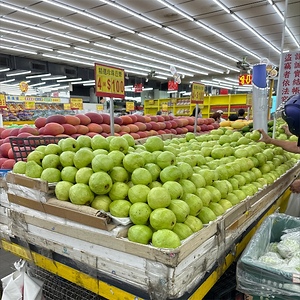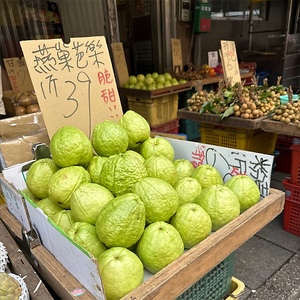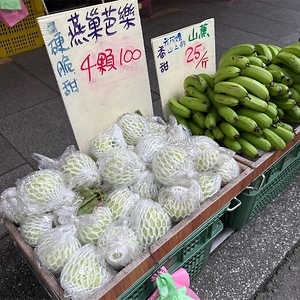


Pearl Guavas
Estimated Inventory, lb : 0
Description/Taste
Pearl guavas vary in size, depending on the season and growing conditions, but are generally a larger varietal in Taiwan, averaging 9 to 10 centimeters in diameter and 9 to 11 centimeters in length. The fruits are typically round, oblate, to slightly pyriform in shape with blunt, curved ends, and are ideal for commercial markets when they range between 400 to 450 grams in weight. The guava’s skin ripens from green to lighter shades of yellow-green and the surface is taut, textured, and glossy. In Taiwan, guavas with a bumpier consistency are considered sweeter, more nutritious, and overall, of better quality than smoother guavas. Underneath the surface, the white to ivory flesh is firm, dense, aqueous, crisp, and crunchy. The flesh is thick and encases tiny light brown to yellow hard seeds. These seeds are edible and can be swallowed but they are not recommended to be chewed. Pearl guavas should feel heavy for their size when ripe and will have a floral aroma. Mature fruits are sweet, varying from 10 to 15 degrees Brix, a measurement of sugar, and have a fragrant, fresh, floral, musky, and subtly tangy taste.
Seasons/Availability
Pearl guavas are available year-round. In Taiwan, guavas harvested from June to September will be the largest. Guavas with the best flavor are gathered between October and February.
Current Facts
Pearl guavas, botanically classified as Psidium guajava, are a Taiwanese variety belonging to the Myrtaceae family. The fruits grow on evergreen trees and are an everyday variety cultivated year-round as a fresh-eating fruit. There are several varieties of guava commercially grown throughout Taiwan, and Pearl guavas are the dominant cultivar, accounting for over 90% of the guavas produced in the country. Guavas are a common fruit sold in Taiwanese markets and are widely available, but their preferred season is throughout the winter when the fruits are their crunchiest. Growers favor Pearl guavas for their high yields, productive nature, hardiness, and resistance to diseases and pests. Despite their improved cultivation traits, the fruits must be handled with care as the skin can discolor if touched. It is traditional for Pearl guavas to be wrapped in Styrofoam and encased in a plastic bag during cultivation to protect the fruits as they grow. Each fruit is also handpicked to prevent pieces of the fruit from being ripped out during harvest. Pearl guavas are picked when they are 80 to 90% ripe to retain a crunchy texture and develop a robust flavor. The guavas are consumed once ripe and are primarily eaten as fresh-eating fruits. Pearl guavas can also be used in any cooked preparation calling for guava. When fresh, Pearl guavas grown in the winter will be of the best quality, as the summer season has a shorter growing window, and the fruit may become softer due to the heat.
Nutritional Value
Pearl guavas have not been extensively studied for their nutritional properties. Guavas, in general, are a source of fiber to regulate the digestive tract, vitamin C to strengthen the immune system, potassium to balance fluid levels, and calcium to protect bones and teeth. Guavas also provide iron to develop the protein hemoglobin for oxygen transport through the bloodstream, phosphorus to produce genetic material such as DNA and RNA, and other nutrients, including niacin, riboflavin, magnesium, zinc, copper, manganese, and folate. In Traditional Chinese Medicine, guavas are believed with help with digestion and lower blood sugar levels.
Applications
Pearl guavas have a sweet and floral taste suited for fresh and cooked preparations. In Taiwan, Pearl guavas are traditionally eaten out of hand and the skin, flesh, and seeds can be consumed. Guavas are enjoyed as a stand-alone snack and the crispier, sweeter fruits are the most desired. Pearl guavas can also be sprinkled with chili powder, salt, or plum powder for enhanced flavoring or sliced into salads as a crunchy addition. Try adding Pearl guavas pieces to yogurt as a sweet topping or blend into various smoothies and juices. It is common to combine Pearl guavas with sugar or honey in refreshing beverages throughout Taiwan. Street vendors often sell this beverage year-round and guava drinks are made at home as a nutritional drink. In addition to fresh preparations, Pearl guavas can be incorporated into various desserts such as mousses, cakes, tarts, or poached in syrups. Pearl guavas can also be simmered into jellies and jams and combined with cheeses. While less common, guavas can be cooked into soups, pickled as a tangy condiment, or dried for extended use. Dried Pearl guavas are a prevalent souvenir and are sold individually or dipped in chocolate as a dessert. The fruits are also dried into tea or canned as a commercial good. Pearl guavas pair well with fruits such as coconut, dragon fruit, honeydew, and passionfruit, honey, vanilla, and cinnamon. Whole, ripe Pearl guavas will keep for 1 to 2 weeks when stored in the refrigerator. The fruits should only be washed just before use and consumed quickly after ripening for the best quality and flavor.
Ethnic/Cultural Info
Pearl guavas were named for their white flesh and superior qualities. Historically, pearls were revered in Chinese culture as a symbol for purity and prosperity. It was common for pearls to be adorned on clothing and headdresses of royalty and in ceremonies and artwork, dragons often chased pearls in a symbolic quest for wisdom. Pearls were also used in natural medicines and beauty treatments for their luster. These qualities inspired the commercial name of the Taiwanese, white-fleshed guava as the variety showcased improved flavoring, texture, and cultivation characteristics. Pearl also embodied the idea of a regal and pure fruit. One of the unique characteristics of Pearl guavas is their crunchy nature. When guavas were first planted in Taiwan, there were only varieties that had softer-textured flesh. Over time, new varieties were introduced and selectively bred in Southern Taiwan to create a denser texture, as this was the preferred consistency in the country. Southern Taiwan also provided a growing environment with fertile, rich soil and ideal climatic conditions to create a variety with a sweet taste and firm flesh. Pearl guavas are known for their crisp and snappy consistency and the crunchiest fruits are the most revered in local markets.
Geography/History
Pearl guavas are native to Taiwan and were developed from selective breeding of Thai varieties. Guavas, in general, were first introduced to Taiwan several hundred years ago and varieties from Asia, Southeast Asia, and the United States were planted on the island in the early 20th century. In 1975, Thai guavas were notably brought to Taiwan and Taiwanese growers began using these introduced varieties to breed improved cultivars. Much of the history of Pearl guavas is unknown, but it was thought to have been developed from Thai varieties sometime in the late 20th century. It is said the variety arose in the 1990s from the garden of Chen Yuzhan in the Dashe Township of Kaohsiung. Pearl guavas were favored as an improved variety as they exhibited better resistance to pests, were faster growing, and developed a sweeter and crunchier texture. Since their creation, Pearl guava cultivation quickly expanded across Taiwan and became the choice variety for commercial growers. Today, Pearl guavas are produced in the counties of Kaohsiung, Tainan, Nantou, Chiayi, Yilan, and Changhua County in Taiwan, with the main production regions in Yanchao and Dashe in Kaohsiung and Shetou in Changhua City. Pearl guavas are also exported to Canada, Hong Kong, and Macao. The Pearl guavas featured in the photograph above were sourced through the farm of Li Li Kuei in Southern Taiwan.










